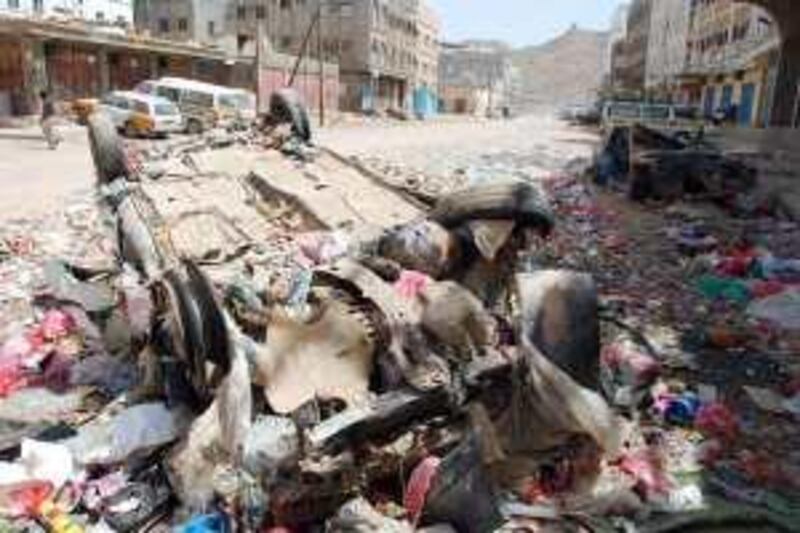The uncharacteristically green-tinged hills around the port city of Mukalla provide the only upside of the devastating floods that ravaged eastern Yemen nearly seven months ago. What is normally a barren area now supports flourishing vegetation although the streets below remain substantially unrepaired, with intermittent ribbons of tar seal and carcasses of vehicles lying just as they were when they emerged from the water in late October.
The main motorway inland to Wadi Hadramaut is little better. It has been reopened to traffic but attempts to repair the road to the standard it was before have been abandoned in favour of the simpler and cheaper - but more ephemeral and risky - solution of paving a lower route directly on parts of the boulder-strewn riverbed. Throughout Hadramaut and Mahara regions, an estimated 25,000 people have been displaced by the floods and more than 110,000 have been affected. The damage to agriculture in the Wadi Hadramaut valley alone is estimated at US$360 million (Dh1.3bn).
And that is the situation confronting a delegation from the UAE's Red Crescent Authority, which arrived in Yemen last week, aiming to help fulfil the pledge by Sheikh Khalifa, President of the UAE and Ruler of Abu Dhabi, who said soon after the floods that the Emirates would replace or repair 1,000 of the 3,200 homes destroyed or rendered uninhabitable in Hadramaut and Mahara provinces. The UAE had already begun fulfilling its matching promise of food aid to Arabia's poorest nation, delivering the first shipment of 500,000 tonnes of wheat in January. Immediately after the floods, it also established a field hospital capable of treating 100 patients and dispatched generators and supplies of water.
The Dh100m new development for the flood victims will be known as Khalifa City, according to the state news agency WAM. Abdul Rahman al Tunaigi, the RCA's spokesman, said the project was only now getting under way because of specific building requirements and traditional architecture in the Hadramaut region. Yemen's president, Ali Abdullah Saleh, expressed the nation's appreciation at the help from the UAE when he visited Abu Dhabi this year.
"We wish to express our gratitude and appreciation to the UAE," Mr Saleh said at the time, "for their support for Yemen and its development; notable among this is the generous support during the flood that hit the Hadramaut region in Yemen." Mohsen al Duwailah, head of the Charitable Society for Social Welfare (CSSW) in Sayun in Wadi Hadramaut, told the United Nations-organised humanitarian news agency IRIN last month that rebuilding homes was the single most important goal for the aid work now.
Some of the Yemenis displaced by the floods are still living in UN-provided tents on pieces of scrap land beside the motorway. He said others have had to move in with relatives and some were living in homes rented by local aid agencies. The CSSW rents homes for 425 families in the Hadramaut region but that came with a subsidy that lasted for six months, a time span now coming to an end without any replacement housing being created.
"Some flood victims have told us they won't be able to afford the rent when their temporary lodging period is finished," he said. Mr al Duwailah said that apart from the 25,000 people displaced by the floods, he estimated there were another 18,000 who needed food aid but were not listed to receive it. IRIN also quoted Yemeni officials warning that the rebuilding or replacement of homes for those displaced by the floods would take time. The reconstruction fund was started in December but an executive director was appointed only at the end of February. Plots for new homes were being allocated but because they had to be built in the traditional style of the Hadramaut and out of mud brick, completion might be a year away.
The efforts by international agencies had also been affected by the terrorism afflicting the region. After four South Korean tourists and their Yemeni guide were murdered by a suicide bomber in Shibam in March, aid workers from groups such as the World Food Programme were prevented from operating for another 10 days. The UAE's response to the floods has been praised by Mukalla-based Islamic Association (IA), which worked with the UAE Red Crescent Authority to form a group of doctors who toured the villages in Hadramaut, providing free health care.
The head of the IA, Ali Abdullah al Ham, said Yemeni non-government organisations like the IA also combined with Mukalla's Al Ahg f University to assist 4,500 families in the affected regions within the first two weeks, when the needs were most acute. "The first thing we did was to form relief committees to go to flood-stricken areas to assess the situation, and also distribute urgently needed aid," he told IRIN.
"We set up an emergency operations room in Mukalla to receive information from the affected areas. We provided the students with satellite phones to use in remote areas." IA estimated that it helped distribute 5,000 sacks of rice, 2,300 bags of flour and tonnes of wheat, cooking oil, milk, canned fish, tea, 6,000 blankets and nearly 1.5 million litres of water. Mr al Hamed declined to say how much it had spent but said most funds had been donated by the Gulf countries.
The IA had also said that within two months of the floods it had finished plans to build 100 houses in the Hadramaut and Mahara regions. jhenzell@thenational.ae zconstantine@thenational.ae






